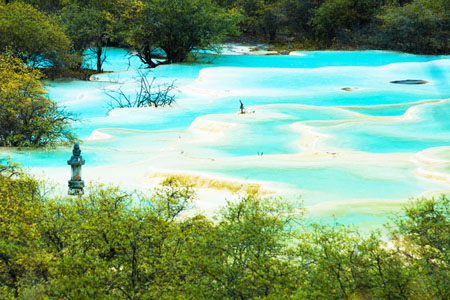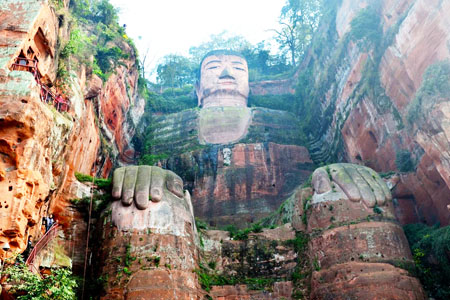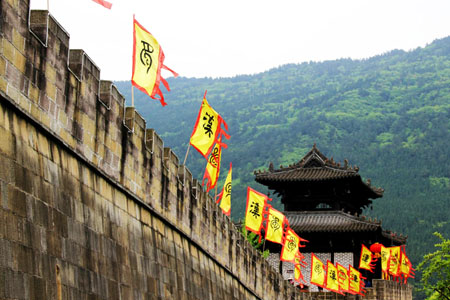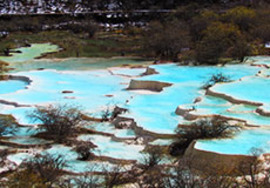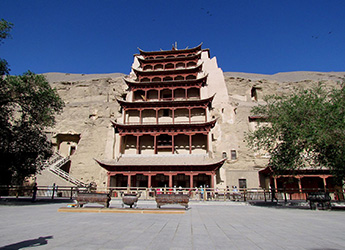 Situated at a strategic point along the Silk Route, at the crossroads of trade as well as religious, cultural and intellectual influences, the 492 cells and cave sanctuaries in Mogao are famous for their statues and wall paintings, spanning 1,000 years of Buddhist art.
Situated at a strategic point along the Silk Route, at the crossroads of trade as well as religious, cultural and intellectual influences, the 492 cells and cave sanctuaries in Mogao are famous for their statues and wall paintings, spanning 1,000 years of Buddhist art.
Outstanding Universal Value
Brief synthesis
Carved into the cliffs above the Dachuan River, the Mogao Caves south-east of the Dunhuang oasis, Gansu Province, comprise the largest, most richly endowed, and longest used treasure house of Buddhist art in the world. It was first constructed in 366AD and represents the great achievement of Buddhist art from the 4th to the 14th century. 492 caves are presently preserved, housing about 45,000 square meters of murals and more than 2,000 painted sculptures. Cave 302 of the Sui dynasty contains one of the oldest and most vivid scenes of cultural exchanges along the Silk Road, depicting a camel pulling a cart typical of trade missions of that period. Caves 23 and 156 of the Tang dynasty show workers in the fields and a line of warriors respectively and in the Song dynasty Cave 61, the celebrated landscape of Mount Wutai is an early example of artistic Chinese cartography, where nothing has been left out – mountains, rivers, cities, temples, roads and caravans are all depicted.
As evidence of the evolution of Buddhist art in the northwest region of China, the Mogao Caves are of unmatched historical value. These works provide an abundance of vivid materials depicting various aspects of medieval politics, economics, culture, arts, religion, ethnic relations, and daily dress in western China. The unique artistic style of Dunhuang art is not only the amalgamation of Han Chinese artistic tradition and styles assimilated from ancient Indian and Gandharan customs, but also an integration of the arts of the Turks, ancient Tibetans and other Chinese ethnic minorities. Many of these masterpieces are creations of an unparalleled aesthetic talent.
The discovery of the Library Cave at the Mogao Caves in 1990, together with the tens of thousands of manuscripts and relics it contained, has been acclaimed as the world’s greatest discovery of ancient Oriental culture. This significant heritage provides invaluable reference for studying the complex history of ancient China and Central Asia.
Criteria (i): The group of caves at Mogao represents a unique artistic achievement both by the organization of space into 492 caves built on five levels and by the production of more than 2,000 painted sculptures, and approximately 45,000 square meters of murals, among which are many masterpieces of Chinese art.
Criteria (ii): For 1,000 years, from the period of the Northern Wei Dynasty (386-534) to the Mongol-led Yuan Dynasty (1276-1386), the caves of Mogao played a decisive role in artistic exchanges between China, Central Asia and India.
Criteria (iii): The paintings at Mogao bear exceptional witness to the civilizations of ancient China during the Sui, Tang and Song dynasties.
Criteria (iv): The Thousand-Buddha Caves constitute an outstanding example of a Buddhist rock art sanctuary.
Criteria (v): Occupied by Buddhist monks from the end of the 19th century up to 1930, the rock art ensemble at Mogao, administered by the Dunhuang Cultural Relics Research Institute, preserves the example of a traditional monastic settlement.
Criteria (vi): The caves are strongly linked to the history of transcontinental relations and of the spread of Buddhism throughout Asia. For centuries the Dunhuang oasis, near which the two branches of the Silk Road forked, enjoyed the privilege of being a relay station where not only merchandise was traded, but ideas as well, exemplified by the Chinese, Tibetan, Sogdian, Khotan, Uighur and even Hebrew manuscripts found within the caves.
Integrity
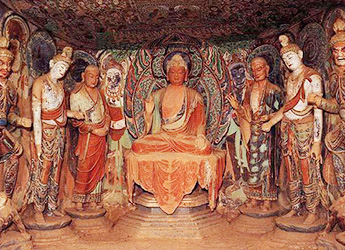 Mogao Caves encompass caves, wall paintings, painted sculptures, ancient architecture, movable cultural relics and their settings. The property area and buffer zone contain all the attributes that demonstrating the values of the Mogao Caves and thus ensure the integrity of both the heritage site and its environment. Documents of Western Xia, Central Asian and Phags-pa scripts had been discovered through archaeological investigations in the 243 caves in the northern area of Mogao Caves, which was the area for monks to live and meditate and also served as the graveyard in the past. The Mogao Caves comprise the Northern Area and Southern Area caves together.
Mogao Caves encompass caves, wall paintings, painted sculptures, ancient architecture, movable cultural relics and their settings. The property area and buffer zone contain all the attributes that demonstrating the values of the Mogao Caves and thus ensure the integrity of both the heritage site and its environment. Documents of Western Xia, Central Asian and Phags-pa scripts had been discovered through archaeological investigations in the 243 caves in the northern area of Mogao Caves, which was the area for monks to live and meditate and also served as the graveyard in the past. The Mogao Caves comprise the Northern Area and Southern Area caves together.
Authenticity
The location of the Mogao Caves and its settings are faithful to the authentic historical context in which they were created. The design, materials, traditions, techniques, spirit, and impression of the caves, wall paintings, painted sculptures and movable cultural relics still exhibit the characteristics of the periods in which they were created. The continued utilization of the Mogao Caves for tourism has indeed promoted its historic significance. Conservation plans have established the guidelines for the caves’ utilization and conservation and therefore will ensure the authenticity of the site and its settings.
Protection and management requirements
The Mogao Caves were inscribed on the World Heritage List in 1987. As a State Party, China has put all World Heritage sites under top-level protection. In 1961, the Mogao Caves was listed as one of the State Priority Protected Sites by the State Council and was put under the protection of national laws including the Law of the People's Republic of China on the Protection of Cultural Relics. The Regulations for the Conservation of the Mogao Caves in Dunhuang, Gansu Province (2002) has confirmed the boundaries of the conservation area, and the Master Plan for the Conservation of the Mogao Caves at Dunhuang (2006-2025), which has been reported to the Gansu Provincial Government and will be issued soon, adds the area for the control of construction, which overlaps with the buffer zone. The two directives are the most important measures taken for preserving the authenticity and integrity of the Mogao Caves. The Administrative Institution of the Mogao Caves has been cooperating with international counterparts to study conservation and site management and looks forward to continuing its work in preserving the heritage of the site.
The goal in the future is to implement the measures set out in the management plan by the scheduled time, to learn from advanced experiences in heritage site conservation and management at home and abroad, to ensure the authenticity and integrity of the heritage site and its setting, and to make its full historical information and value available to future generations.
Long Description
The group of caves at Mogao represents a unique artistic achievement as much by the organization of space into cells and temples built on five levels as by the production of more than 2000 sculptures carved out of the rock walls, then covered with clay and painted, and the approximately 45,000 m2 of murals, among which are many masterpieces of Chinese art.
In the desert landscape of the extreme north-west of Gansu Province are the cliffs of Mogao, which form the eastern edge of Mount Mingsha. The cliffs rise above the Dachuan River, which is 25 km south-east of the Dunhuang oasis. Within the cliffs are the 492 natural cells and rock sanctuaries extending over 1,600 m that make up the famous Caves of a Thousand Buddhas (Qianfodong). The history of these caves is inseparably linked with that of the first Chinese expeditions against the nomads of the Mongolian steppes and Central Asia.
After the almost complete failure of the expedition of Zhang Qian in the ancient country of Bactria in 139-126 BC, a long section of great walls was built to protect the northern frontier. In 117 BC, military posts, like that of Dunhuang, were established. Two years later, the number of these command posts was doubled. Control of the Hexi pass and the oases route, which was the central segment of the Silk Route that connected China with the Mediterranean world, was the motivating factor in the incessant conflicts between the Chinese sovereigns and the nomads.
Dunhuang would remain cut off from the Middle Empire for long periods at a time, and so constituted a cosmopolitan enclave where all the peoples of Asia mingled together. Many foreign religions were represented, and devotees of Buddhism, Nestorianism and Islam could be found in this caravan oasis. According to an inscription, Buddhist monks first began work on the caves of Mogao in AD 366, whereas the state officially recognized Buddhism as a religion only in 444.
The majority of the cells and temples were constructed, however, from the 5th century up through the 14th century, when the region began to decline. Several great moments of the history of Central Asia are illustrated in the caves and frescos that illustrate doctrinal themes, reflecting transcendental teaching, correspond to the period in the 7th century when the Tang dynasty tightened its control of the Silk Route.
The first Tantric themes appear at the time of the occupation of Dunhuang by the Tibetans, from 790 to 851. Following the conquest of Gansu by the Tanguts, these themes multiplied, encouraged by the proliferation of lama sects under the Western Xia (1036-1227). With this same invasion in 1036 correspond the 45,000 manuscripts discovered in 1900 by the Taoist monk Wang Yuan-lu (Wang Guolu) in a cave where they had been hidden at the approach of the Tanguts. Although dispersed, this fabulous collection is one of the essential sources of Asian history.
The Mogao caves are closely associated with the history of transcontinental relations and that of the propagation of Buddhism in Asia. Being so strongly linked with the history of China, they constitute an anthology of Buddhist art with paintings and sculptures spanning a period of a thousand years. Moreover, since they were still occupied by Buddhist monks from the end of the 19th century until 1930, the rock-art ensemble at Mogao, administered by the Dunhuang Cultural Relics Research Institute, preserves the example of a traditional monastic settlement.
The History of Mogao Grottoes
The time of building Mogao Grottoes are slightly different in different documents. At present, most scholars agree with the view that it was started from the second year of the former Qin Jianyuan (366 AD) when Monk Le Zhun dug caves in the Mogao Grottoes, and then Zen Master Faliang continued to build them. By the Beiliang period, a small community of monks had been formed here. These caves began served as meditation places for hermit monks, but later developed to serve the rise of the nearby monasteries. Since then, under the influence of Buddha worship statues, the Mogao Grottoes began to develop rapidly. In the early Sui and Tang dynasties, Dunhuang became the main commercial hub and an important religious center of the Silk Road. Meanwhile, the Mogao Grottoes also entered its heyday and became a place of pilgrimage for all parties. During this period, numerous caves were built in the Mogao Grottoes, including two large image niches. As an aid to meditation, as a teaching tool to promote Buddhist beliefs and stories to the illiterate, the caves and interior murals and statues are carefully built. The main caves are usually sponsored by Buddhist monks, local ruling elites, and emperors of the Central Plains, while others are funded by business travelers, military officers, and local people (such as women's groups).
In the 914 AD, the Cao Yijin family ruled Guazhou (Anxi) and Shazhou (Dunhuang) for more than 120 years. They built a large number of caves in Dunhuang, repainted and rebuilt the caves and eaves of the previous generation, and painted large areas of open-air murals on the cliff surface, making the appearance of Mogao Grottoes magnificent.
During the scenic period of the Northern Song Dynasty, Dunhuang was successively ruled by the Xixia and the Mongolian regime. Although there were still some things restored and repaired, the Mogao Grottoes declined with the loss of the important role of the Silk Road and the economic depression of Dunhuang. After the yuan yuan, stop opening the caves.
The discovery of the Mogao Grottoes
The Mogao Grottoes were once abandoned in the Ming Dynasty and were little-known. It was not until the 20th century that Dunhuang attracted the attention of the world again, which was closely related to the discovery of the Sutra cave by Wang Yuanlu (1849-1931). Wang Yuanlu was a Taoist priest who came to the Mogao Grottoes in Dunhuang around 1890 AD and settled there. He described himself as the folk guardian of the grottoes and went to raise money to repair the temple. In the 1900, while cleaning the sand in Cave 16, one of his workers suddenly found a secret door with a small secret room, hidden full of volumes and paintings from the 4th to the 11th century. After the discovery of the cave, British M.A. Stein (Marc Aurel Stein, 1862-1943), French Bosch, Japanese Orange Ruichao and Jiro Yoshikawa successively took a large number of scriptures and other cultural relics in the cave. Russian S.F. Сергеи федорович Ольденбург (1863-1934) and American L. Warner also stole some murals in the Mogao Grottoes. These robberies and destruction caused great losses to Dunhuang cultural relics. At the same time, some of them began to number, map, photograph and write down the caves by archaeological methods, and published some photos and materials of the Dunhuang grottoes.
After more than 100 years, all the exposed and buried caves have been cleaned and excavated, archaeologists found that there are 248 caves in the area (including the numbered 461-465 caves), and basically clarified the structure, use, function and age of each (or group) caves. Among them, there are monk caves where monks lived, Zen caves for practice, grain caves for storage, and burial tombs, which have different forms and functions. Cleaning also unearthed many relics, coin of Persian silver coin, Kaiyuan tong bao, song dynasty copper iron coin, Xixia iron coin, wooden woodcarving terracotta figure, Huihe wooden movable type, clay sculpture tower, Buddha, shadow, copper cross, metal iron cutter and literature of Chinese, Xixia, Huihe, Tibetan, Mongolian, Sanskrit, eight thought, Syria and other kinds of ethnic literature and daily necessities, etc. Relics and relics show that the North District is an area where the monks move.
The modern research and protection of Dunhuang grottoes are also increasingly international and institutionalized. In 1983, the Dunhuang Turpan Society of China was established. In 1984, the expanded Dunhuang Institute of Cultural Relics was renamed the Dunhuang Academy. In 1987, the Dunhuang Mogao Grottoes were listed in the "World Cultural Heritage List" by UNESCO. In the same year, The Japanese Qingshan donated 8 pieces of Dunhuang cultural relics to the Dunhuang Academy, which was the first time that the lost overseas were returned to China.
The main attractions of the Mogao Grottoes
Nine Floors Tower
It is commonly known as the wooden building outside the cave 96. The Tang Dynasty was called the Great Northern Statue. Commonly known as the Giant Buddha Hall. Is one of the representative grottoes of the Mogao Grottoes. The first big grottoes in Dunhuang grottoes was built in the early Tang Dynasty. The cave to the top of the cliff, 40 meters high, nine layers of wooden buildings outside the cave, 45 meters high. There are no paintings on the walls of the cave, and the largest statue (33 meters high) in the Dunhuang grottoes is made like Maitreya Buddha. The height is second only to the Leshan Stone Buddha in Sichuan (71 meters) and the Stone Buddha in Rongxian, Sichuan (more than 36 meters). In the clay sculpture statue, its height is the crown of the whole country.
Three Floors
A cave built by a monk named Wu, the late Tang Dynasty called Wu monk cave. The Mogao Grottoes represent one of the grottoes. Built between the first five years to the eighth year of Xiantong (851-867). The master of the cave was Monk Wu, who was the master of Hexi in the late Tang Dynasty. Located in the ground floor of the north section of the southern district of the Mogao Grottoes. It is the 365 cave (seven Buddha hall), the top is the 366 cave, three caves in front of the three layers of wooden cave eaves, namely three floors.
Preserving Buddhist Sutra Cave
Cave 17 of the Mogao Grottoes, also known as the "Mingsha Stone Room" and "Dunhuang Stone Room", is located in the north wall of the tunnel of Cave 16. It was built between the fifth year of the Tang Dynasty to the third year of Xantong (851-862). It was originally the Buddhist cave of the late Tang Dynasty. After the death of Hong, his subordinate monk or Wu family changed the Zen Grottoes to the shadow Hall. The plane of the cave is nearly square, with a bucket top, the ground to the top of the cave is 3 meters high, the north wall of a rectangular Zen bed type low altar, sitting on the altar, a clay sitting statue of the monk Hong. North mural two bodhi tree, branches and leaves, to show that Hong sat under the bodhi tree. On the east side of the Bodhi tree, he holds a phoenix ball fan in both hands; on the west side, he draws a close woman with a towel in one hand and a staff in the other hand. The west wall embedded with a large five years hongbody monument. Tens of thousands of ancient Buddhist scriptures, social documents, silk paintings, embroidery, ritual ware and other cultural relics from the 4th century to the 11th century, which are commonly known as "Sutra cave".
Dunhuang Tour Routes and Packages:
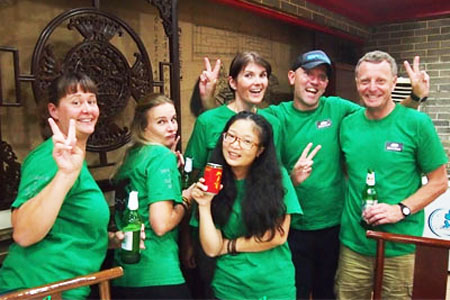
 Situated at a strategic point along the Silk Route, at the crossroads of trade as well as religious, cultural and intellectual influences, the 492 cells and cave sanctuaries in Mogao are famous for their statues and wall paintings, spanning 1,000 years of Buddhist art.
Situated at a strategic point along the Silk Route, at the crossroads of trade as well as religious, cultural and intellectual influences, the 492 cells and cave sanctuaries in Mogao are famous for their statues and wall paintings, spanning 1,000 years of Buddhist art. Mogao Caves encompass caves, wall paintings, painted sculptures, ancient architecture, movable cultural relics and their settings. The property area and buffer zone contain all the attributes that demonstrating the values of the Mogao Caves and thus ensure the integrity of both the heritage site and its environment. Documents of Western Xia, Central Asian and Phags-pa scripts had been discovered through archaeological investigations in the 243 caves in the northern area of Mogao Caves, which was the area for monks to live and meditate and also served as the graveyard in the past. The Mogao Caves comprise the Northern Area and Southern Area caves together.
Mogao Caves encompass caves, wall paintings, painted sculptures, ancient architecture, movable cultural relics and their settings. The property area and buffer zone contain all the attributes that demonstrating the values of the Mogao Caves and thus ensure the integrity of both the heritage site and its environment. Documents of Western Xia, Central Asian and Phags-pa scripts had been discovered through archaeological investigations in the 243 caves in the northern area of Mogao Caves, which was the area for monks to live and meditate and also served as the graveyard in the past. The Mogao Caves comprise the Northern Area and Southern Area caves together.
